Abstract
Common mode-choice models developed under assumption that one will behave rationally to maximize her utility. Arguably, failed to address two key factors: additional income and local interaction. It is evident that most public transportation aims to reduce transport cost, which in result generates additional income and people interaction. Therefore, possible existence of phase in which people purchase automobile after additional income and social prestige is an attractive proposition. An agent-based model of artificial agents created and showed interaction with her neighbors and then update her state, either automobile or public transportation, according to probability function. The higher ratio of agent’s wealth to her neighbors’, the higher probability to purchase automobile. Our model suggests that transportation system is an ever-moving system of three states: transit-oriented, automobile-oriented, and equilibrium. It also describes inverse relation between state of the system and its social implications. By favoring the poor encourages people to view automobile much more prestigious than public transport, hence prestige-driven behavior emerged automobile-oriented system. The model could also be viewed as a generalized form of conventional model. It shows that rational behavior and utility maximization only occurs when purchasing automobiles is considered costly, thus, functionality and degree of necessity becomes critical.
Keywords: Agent-based modelautomobilelocal interactionpublic transportationsocial inequity ”
Introduction
Transportation system is always developed towards efficiency by means of minimizing the total costs and maximizing the total benefits (Litman, 2014). In this spirit, public transportation systems are developed at the expense of private transportation. It is evident that public transport does reduce total transport cost, however, if the total costs is reduced, then people will have additional income to spend, then the remaining question is what to do with the additional income.
An intriguing fact that automobile sales and production shows a constant increasing trend as shown in Figure

Another amusing fact is that it is rarely seen high-class people use public transportation. Using the graph shown in
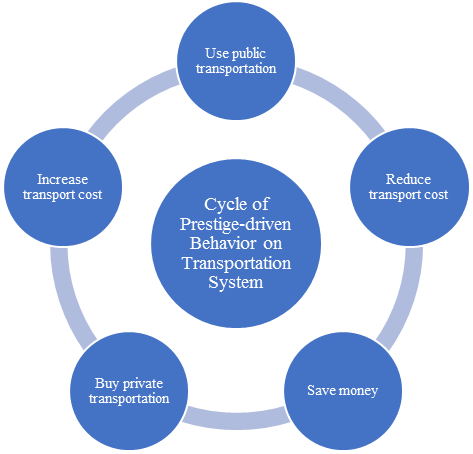
The question now is what kind of system does this cycle produce? It is widely known that a good public transportation system will attract people to shift from private transportation. However, the facts do not fully support that argument. Behavioral cycle is the key factor in transport mode choice decision-making in the sense that social structure is the core idea of people in viewing transportation mode as a means to excel their social status, thus, a particular transport mode is most likely to be chosen also based on its level of prestige.
Problem Statement
Generally, one’s preference over a product could be distinguished by three variables, i.e. price, quality, and prestige. These variables have different social properties. Low-class people consider price over quality and prestige, middle-class people put quality over price and prestige, whereas high-class people regards prestige above all (see Figure
Considering hypothetical situation, one in a store and want to buy a particular product. The store offers three products to choose. Product A is a low quality and cheap product. Product B is a medium quality product and is more expensive than product A. Product C is the most expensive product even though there is no significant different in the quality compared to Product B. Scenario 1, if one belongs to the low-class group of people, then one will not think much and buy Product A. The product bought because it is the only choice one have, provided very limited economic resource.
Scenario 2, if one belongs to the middle-class group of people then one are most likely to have a deep consideration of which product to buy, he wants the best quality product with the lowest price. Unfortunately, with his economic limitation, if he buys Product C then he will sacrifice his future life. However, he does not want to buy Product A since it has lower quality than Product B even though it has cheaper price and thus, you will buy Product B since it is affordable to you and it has a proper quality.
Scenario 3, if one is a rich guy then he will not think much on which product to buy. In a split second, he will take Product C and go to the cashier to pay it. He buys it because he can and because he does not want to have the same product with lower-class group of people. This type of behavior in an evidence of wealth and honorific, and conversely, the failure to consume in due quantity and quality becomes a mark of inferiority and demerit (Veblen, 1899). Goods in which people’s preference for buying them increases as a direct function of their price is called to possess ‘Veblen effect’, therefore the ‘Veblen effect’ is exist whenever a consumer is willing to pay a higher price for a functionally equivalent good (Hinz, Spann, & Hann, 2010).
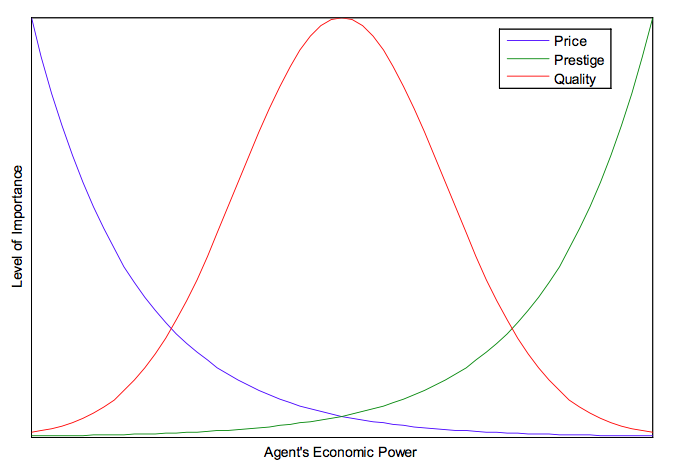
This hypothetical situation illustrate that in this modern world people buy products not only for the functionality or degree of necessity, but also related to the profile beneficiaries (Situngkir, 2010). Prestige plays a key role in one’s preference. Imagine that this kind of behavior applied to the case of transportation mode choice. People choose transportation mode not merely based on its attributes but also based on how prestigious they are. The facts that the constant increase in automobile sales in the last decade (see Figure
To be more precise, assume an individual has
amount of money, the cost of using public transportation is
, and the cost of using private transportation is
. It is obvious that
. If she does not have a private transportation, she will use public transportation and thus, she will have
to save. As time goes on, her saving will be accumulated and eventually she will have
. Yet, the most interesting part is what will happen when
? According to the previous discussion, transportation decision-making is governed by prestige-driven behavior; thus, when the condition of
is satisfied, she will obviously buy a private transportation. Hence, we could convinced that people use public transportation, at first, merely to save their money and when they have the adequate amount of money, they will shift to private transportation and vice versa, which produce a cycle of behavior (see Figure
Research Questions
This paper is constructed based on the idea that there is a strong relationship between social interaction and transport mode choice. Thus, this paper is an attempt to provide solution to the question of how does social interaction influence transport mode choice decision making and what kind of system that it produced.
Purpose of the Study
This paper aims to investigate at what condition, in terms of public and private transportation cost ratio, that phase transition in transportation system occurs.
Research Methods
Transport mode choice decision-making is a result of local interaction among agents. Consequently, the logic behind why does one choose a particular transport mode is not only because of how one perceived its quality but also of how one respond to her social network’s influence. Mathematically speaking, it could be written as a set of artificial agent
, who live in a two-dimensional lattices world as shown in Figure
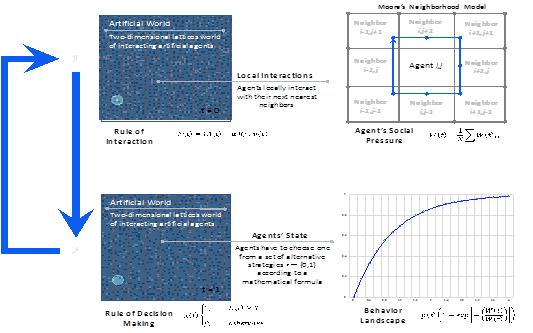
Moreover, each agent has to choose one from a set of alternative strategies , which are updated in parallel in every time step. Alternative strategy corresponds with private car and corresponds with public transportation. Each agent is modeled as a bounded rational (Arthur, 1994) entity which only has limited information about the other agent’s decision and do not have any information regarding the global state of the system. Accordingly, each agent will have to make a temporary hypothesis about the benefit they could gain when choosing a certain mode of transportation. The temporary hypothesis is agent’s subjective thought, which is formulated as follows:
The idea behind the agent’s subjective thought equation is very simple. The first term on the right-hand side of the equation explains agent’s ability to buy a private car and the second term explains about agent’s probability of buying a private car. For instance, imagine a situation where an agent has to choose whether she use a private car or a public transportation. A rich agent ( ) has the ability to buy a private car. Though it is not a definite that she will buy a private car, assuming that agents are motivated to have a better social status than her neighbors, agents will have higher probability to buy a private car if her neighbors have lower social status in average.
Agent’s ability to buy a private car, the first term of the equation, depends on two variables, i.e. agent’s current economic state
Income
denotes the agent’s car ownership. If an agent owns a car (
) then the maintenance cost of the car
Moving to the second term of the equation, probability of an agent to buy a private car depends on agent’s social status compared to her social network. Agent’s social status is assumed to be a manifestation of agent’s wealth. Rich agents behave differently from poor agents. Rich agents are most likely to have a luxurious lifestyle while poor agents are most likely to have minimalistic lifestyle. Like it or not, the rich tend to look down the poor while the poor tend to envy the rich to the extent of dislike them. In other words, rich agents do not want to be equal with poor agents. They simply want to be superior to the poor. Thence representing agents’ probability to buy a private car by the differences between agents’ wealth is a plausible approximation.
Notice that we introduce another economic-related term: agent’s wealth. Agent’s wealth is different from agent’s current economic state. Agent’s wealth is the value of the overall economic state of an agent, which also put his non-liquid possession, such as a car, into account, whereas agent’s current economic state only accounts agent’s liquid asset which will be used for practical use, such as to buy a car or pay the public transportation fare. Agent’s wealth is computed according to the following equation
The equation simply says that if an agent owns a car ( ) then the value of the car will be accounted as agent’s non-liquid possession or simply agent’s wealth. On the contrary, if the respective agent does not own a car ( ), then his wealth will be exactly the same as his current economic state. Practically, an agent will compare her wealth with the average wealth of her social network. As a result, the probability of an agent to buy a private car depends on the ratio between her wealth and the average wealth of her social network.
The probability to buy a private car is assumed to increase as the ratio between agents wealth with the average wealth of her social network increased. denotes the difference of agent’s and her social network’s wealth with as the respective agent’s wealth and as the average wealth of her social network. It is easy to understand that agents want to be around people with the same class or social status with her. Then if the average wealth of her social network is lower than her, she will more likely to buy a private car. Note that the average wealth of agent’s social network also includes the respective agent’s wealth into the computation since she will ask herself, “What would it look like if I live in this neighborhood?”
Agents decision in choosing whether to use private car or public transportation will need to exceed some non-negative threshold
Last but not least, to make it more realistic, we also add a few more additional rules, i.e. car selling and agent removal. It is obvious that each agent who owns a car also has a choice to sell her car. A car will always diminish its value proportional to a certain parameter known as depreciation value and it is exogenous and fixed for the lifetime. Then, the value of the car at the next time step is equal to the value of the car at the current time step multiplied by the depreciation value. Or simply,
Hence, an agent will sell their car when V reached a certain tolerable condition of the respective agent. Parameter is introduced to represents agent’s tolerance. In this model is exogenous, uniformly distributed across agents, and is fixed for the lifetime.
The logic behind the equation is simple. A less-tolerant agent will be brave enough to sell her car even though the car value is still high. On the contrary, a tolerant agent will tend to keep her car as long as possible and will only sell her car when it is close to its maximum lifetime, i.e. . Simply put, if an agent is currently using a private car then when the condition is satisfied then the agent will sell her car, otherwise, she will keep her car. The sell price of the car will be proportional to a random parameter times its buy price. Hence, each agent who sells her car will gain a different selling price.
In the case of agent removal rules, we defined two rules. Agents who are too old will be removed from the simulation. Agent will also be removed if they do not have the adequate economic resource. Or simply, agents will be removed when they went bankrupt. Notice that bankruptcy is defined as the inability of agents to access public services and thus, if an agent does not have the required economic resource to pay the public transportation fare, i.e. , she will be considered as bankrupt and will be removed from the simulation. A new agent will instantaneously replace the removed agent.
Findings
The simulation shows that transportation system is an evolving system with two critical points (see Figure
Below the first critical point, public transportation is much more preferred than private car. It is simply because a free or cheap private car is not prestigious and thus, it does not excel one’s social value. Consequently, it is hard for agents to encounter lower or higher social status agents in her social network. Thus, agents found that there is no point in buying a private car. This is a condition commonly known as transit-oriented transportation system in transportation studies.
Although it is fascinating in the perspective of transportation system, it has an immense implication to the society. At this point, the rich are the subject of social exclusion. Since people want to be around other people with approximately the same social status with them then the minority will automatically, and unconsciously, excluded. However, there is a significant difference with the common social exclusion discussion. Instead of the poor, the simulation shows that the rich are socially excluded in terms of mobility. Although they have access to the public transportation, the society as a whole “rejects” their presence. Thus, public transportation is practically not available for them. Unfortunately, the common belief that transit-oriented transportation system is the ultimate solution of transportation system is not self-evident. In fact, this phase of the system has its main drawback. Transit-oriented transportation system is strongly related with economic disparity whereas the rich feel uncomfortable to use public transportation.
In recent discussion, it is noted that mobility is a central dimension of social inclusion; hence, lack of mobility will hinder one’s possibility to access spaces of participation in their development (Marmolejo, 2010). However, contrary to that argument, this phase of the system does not hinder one’s possibility of accessing spaces of development since the one who is socially excluded is the rich who has no difficulties in accessing spaces of development. Therefore, social exclusion in transportation system does not necessarily related to economic exclusion as the space of development. The argument does not hold since the rich is one who is socially excluded.
At exactly the first critical point, agents divide themselves in a sophisticated way. The balance between public transportation user and private car user emerges. Approximately half of the population prefers to use public transportation and the rest of the half prefers to use private car. In transportation perspective, this phase of system is known as transport equilibrium (Ortúzar & Willumsen, 2011).
The system arrived at equilibrium as a result of agents’ collective decision in which some agents found that there is no point in buying a private car since they do not have the adequate economic resource or simply because they do not encounter lower social status agents, in average, in their social network. Meanwhile, some other agents encountzXstatus agents in average in their social network. The balance of transportation mode user reflects a healthy social life of the society.
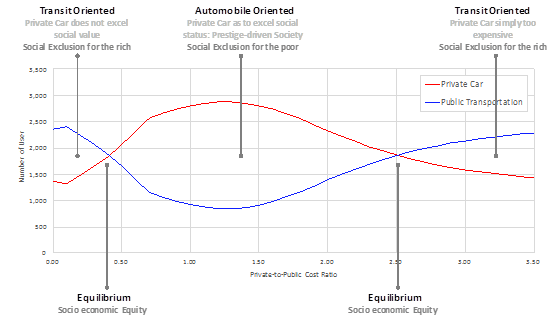
Transport equilibrium is a phase of the system where balance between public and private transportation user emerges and thus provides socio-economic equity to the society. As oppose to transit-oriented or automobile-oriented transportation system, it is simply a transportation system under socio-economic equity. The socio-economic equity of equilibrium system is the main properties of transportation system that makes it the most desirable outcome of a transportation system. However, as shown in Figure
As a back log, this phase of system also has its potential negative effects. This type of society is prone to social disparity. The system is mature enough to support free-market-like social life. If the difference in terms of cost between public transportation and private car is growing bigger, public transportation as a means of transportation for the poor becomes more and more accepted as social norm as well as private car as a symbol for the rich. People who use public transportation as their means of transportation will be less-respected, undermined, and regarded as shameful by the society.
Beyond the first critical point, prestige-driven society emerged and keeps flourishing until it reaches its peak and then decline until it reaches the second critical point. Denotes by the increasing proportion of private car user, the society evolves into automobile-oriented transportation system.
This phase occurs in the condition where most people’s economic power is much higher than the total cost of having private car. Simply put, there is a mispricing of private car, i.e. too low of a price. Thus, people easily buy private car and then, after some times, owning a private car becomes the social norm. Consequently, the one with no private car, which is people who use public transportation, is socially acknowledged as the poor. As a result, the stigmatization of public transportation values private car more than public transportation in terms of social prestige. This is the phase where people use transportation mode as a means to excel their social status. This is exactly the result of a poorly managed transportation system where prestige-neutral society evolves into prestige-driven society; equilibrium transportation systemas the transportation for the poor emerged. Accordingly, private car has promoted as the transportation for the rich.
Imagine a situation where the authority implements a cheap, or even a free, public transportation system policy. The policy will not change the preference of using private car since people do not want to be labeled as the poor and will only strengthening their willingness to buy a private car in order to be accepted as an equal being in the society instead. Automobile-oriented transportation system emerges. In this situation, the gap between the rich and the poor will grow rapidly and resulted in the emergence of economic disparity, which leads to social exclusion for the poor. This is the situation where the common discussions of social exclusion addressed.
At the second critical point, the balance between private car user and public transportation user re-emerges. However, there is a significant difference between this critical point and the previous critical point. People, mostly medium class people, start to realize that they have to accept the fact that private car price is a big burden. At this phase people start to consider other options than buying a private car to invest their money. However, with the fact that the social life is governed by prestige, people will start to consider other affordable commodities as a means of social status. The simplest examples are electronic gadgets such as laptops, smartphones, tablets, etc.
Beyond the second critical point, people, mostly medium class people, have already realized that they have to accept the fact that private car is too expensive for them. People understand that private car is only affordable for the extremely rich group of people. The system evolves into transit-oriented transportation system for once more. Singapore is the perfect examples of this phase.
However, one has to notice that the state of transportation system is always moving: it is a moving target. At some point, the system is in transit-oriented phase, but, before we know it, it already moves to automobile-oriented phase. It is true that equilibrium provides the best outcome; however, equilibrium only happens in an infinitesimal range of time. Equilibrium is only a point of time while transit-oriented or automobile-oriented is an interval of time. It becomes unrealistic to design a transportation system under equilibrium. Equilibrium transportation system does theoretically exist; however, it is practically non-existent. Thus, the best thing to do is to examine at which phase it is currently and provide policies that could lead it to the equilibrium phase. For instance, if a particular transportation system is currently falls at automobile-oriented phase, then one could reduce the total cost of the private car would to bring back the system to equilibrium type I phase. Or else, one could also increase the total cost of the private car to bring toward the system to equilibrium type II phase.
Conclusion
We have shown above that local interaction among agents in transport mode choice decision making is crucial in understanding the behavior of the system. Transportation system is a complex dynamic system in which the dynamics is governed by prestige-driven behavior interaction among agents. Thus, the state of the transportation system is at constant change. The interchanging of transit-oriented and automobile-oriented system never settles down. A self-organizing system at the edge of chaos has the property of constant changing of states (Waldrop, 1992), therefore, transportation system could also be viewed a self-organizing system at the edge of chaos.
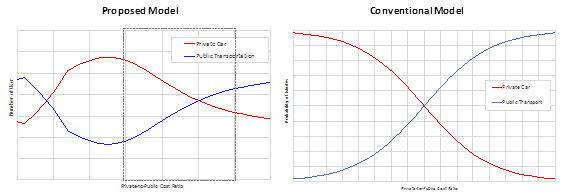
Last but not least, we could also notice that the proposed model could be viewed as a generalization of the conventional Random Utility Theory. The pattern in the area around the equilibrium type II (see Figure
However, as extensively discussed in this paper, this is not self-evident. For example, in the case of traffic congestion, it is widely accepted that a high quality, technically and economically, of public transportation could definitely solve the traffic congestion problem in any condition. Contrary to the common believe, this model provides a powerful evidence of the opposite. The model shows that a cheap and good public transportation could still be the cause of traffic congestion. As long as the system falls in automobile-oriented system, public transportation will more likely to cause more harm than good to the transportation system and society. In a more generalized sense, the conventional Random Utility Theory could predict how people behave when the condition is satisfied as we have already discussed extensively in the first section. As a low point, it could not predict what will happen when the condition occurs. It simply could not capture the dynamics of transportation system. But, still provides a rigorous solution to overcome the limitation of the predictability of the conventional Random Utility Theory.
References
- Arthur, W. B. (1994). Inductive Reasoning and Bounded Rationality: The El Farol Problem. American Economic Review, 84, 406–411. https://doi.org/10.2307/2117868
- Ben-Akiva, M. (1985). Discrete Choice Analysis: Theory and Application to Travel Demand (Vol. 9). MIT Press. Retrieved from https://mitpress.mit.edu/books/discrete-choice-analysis
- GAIKINDO. (n.d.-a). Domestic Auto Market & Production (2003-2015) – GAIKINDO. Retrieved May 15, 2017, from http://www.gaikindo.or.id/domestic-auto-market-production-2003-2014/
- GAIKINDO. (n.d.-b). Domestic Auto Market by Province (2010-2014) – GAIKINDO. Retrieved May 15, 2017, from https://www.gaikindo.or.id/domestic-auto-market-by-province-2010-2014/
- Hinz, O., Spann, M., & Hann, I. (2010). Prestige Goods and Social Status in Virtual Worlds. Icis, 1–14.
- Litman, T. (2003). Social Inclusion As A Transport Planning Issue in Canada. Transport Policy, 1.
- Litman, T. (2014). Socially Optimal Transport Prices and Markets. International Transportation Economic Development Conference, (July), 1–59.
- Marmolejo, D. D. (2010). Guidelines To Mainstream Social Inclusion In Public Transportation Evaluations. A dissertation submitted in partial fulfilment of the requirements for the MSc Social Development Practice, 1–52.
- Ortúzar, J. de D., & Willumsen, L. G. (2011). Modelling Transport. Modelling Transport. https://doi.org/10.1002/9781119993308
- Situngkir, H. (2010). Landscape in the Economy of Conspicuous Consumptions. IDEAS Working Paper Series from RePEc, 1–10. https://doi.org/10.2139/ssrn.1617210
- Veblen, T. (1899). The Theory of the Leisure Class. Journal of Political Economy, 7(4), 425–455. https://doi.org/10.1086/250610
- Waldrop, M. M. (1992). Complexity: the emerging science at the edge of order and chaos. Simon & Schuster.
Copyright information

This work is licensed under a Creative Commons Attribution-NonCommercial-NoDerivatives 4.0 International License.
About this article
Publication Date
01 May 2018
Article Doi
eBook ISBN
978-1-80296-039-6
Publisher
Future Academy
Volume
40
Print ISBN (optional)
-
Edition Number
1st Edition
Pages
1-1231
Subjects
Business, innovation, sustainability, environment, green business, environmental issues
Cite this article as:
Betara, G., & Petroceany, J. (2018). Social Inequity In Transportation System: An Agent-Based Model. In M. Imran Qureshi (Ed.), Technology & Society: A Multidisciplinary Pathway for Sustainable Development, vol 40. European Proceedings of Social and Behavioural Sciences (pp. 474-486). Future Academy. https://doi.org/10.15405/epsbs.2018.05.38

